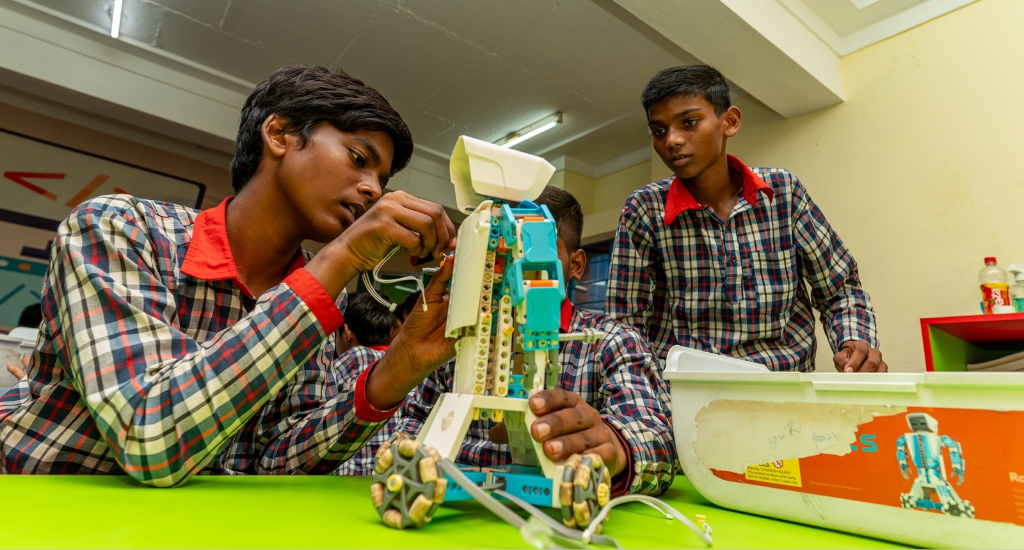
‘Education should make people capable of helping others’
Technology plays an extremely important role in providing access to education and addressing the big rural-urban literacy divide, says Indraani Singh, the founder of Literacy India.

Technology plays an extremely important role in providing access to education and addressing the big rural-urban literacy divide, says Indraani Singh, the founder of Literacy India.
Indraani Singh: I will go a few decades back when I was a kid and went to my mother’s village in West Bengal. I had to travel a long distance to access the toilet.
A few decades later in the early 2000s, when our NGO, Literacy India, began working in Purulia in the state, this problem still persisted. Students had to travel a long distance to access the toilets. This region was also extremely neglected, and faced a constant threat of naxalism. Most government staffers, fearing threat to their lives, would not venture into these areas. But as an NGO we could intervene. We built a small centre with a couple of rooms. We started an education programme for tribal children, which was attended by around 150 of them from surrounding villages, including children of naxalites.
Despite the minimal infrastructure, the intervention brought a big transformation. We were able to scale this initiative and include technology-based learning and skill development programmes for individuals from neighbouring regions. We were able to cover 20 villages in the region.

Making inroads into people’s hearts wasn’t easy and took a lot of time.
Indraani Singh: It’s been 27 years since Literacy India started in 1996. When I was at the peak of my career in the aviation industry, I asked myself, ‘What next?’ I was not so keen on doing something run of the mill. I wanted to do something meaningful and vast. It led me to start with helping a small group of children in the locality with their education.
I started enjoying my time with the children and realised that I could play an important role in improving their lives. One thing led to another and Literacy India became a reality. The organisation now works through a network of over 100 centres in 15 states with an annual outreach towards 65,000 beneficiaries.
Also Read: Girls quit labor work to teach each other
We started in big cities but realised the vast gap that existed in rural India. That’s when I decided to intervene in the villages. We evolved with time, making our education and literacy package in such a way that the beneficiaries are able to stand on their feet. It should be able to make them better individuals, more resilient and capable of helping others.

At Literacy India we believe in four Es – education, empowerment, employability and environment. These four pillars have also evolved over time. We have realised the importance of experiential and engaging learning and therefore this is also at the core of our programmes.
Indraani Singh: Let me give you a recent anecdote. Around 10 days back a woman in her 30’s approached me with teary eyes and asked, ‘Kya aapne mujhe pehchana (do you recognise me)?’ I didn’t recognise her initially. But then she thanked me and told me that she had studied at one of our schools and how that encouraged her to support her two daughters’ education despite several financial and personal challenges.
She is a chef now and has separated from her husband. But I saw resilience and determination in her eyes. A mother’s successful education and empowerment has triggered an intergenerational change.
Indraani Singh: Be it skill development or basic literacy, use of technology is extremely important for us. We started using tech-based strategy quite early on in our work. My exposure and training in science was helpful in thinking through the solutions.
Also Read: How Kollam became India’s first constitution-literate district

We started Gyantantra to address children who have dropped out of school or those with a learning gap who don’t have a basic foundation. Usually limitations in elementary education lead to poor learning outcomes in children attending government schools.
Gyantantra was started in 2009 with the idea of using technology for animation and interactive learning. We did the pilot with street children in Saket, New Delhi, with support from PVR Cinemas. We realised that weaving entertainment into the learning process was important to hold their attention. We created our own pedagogy which went beyond basic learning, and taught students about abuse, alcoholism and substance abuse, trafficking and HIV.
Gyantantra uses a flash-based offline programme, done through animation and interactive games. Subjects such as English and Hindi grammar, basic arithmetic, general studies and environmental science are taught using this.
We have been able to reach more than 3 lakh students through our 110 centres in 17 states. It has been successfully implemented in government primary schools and is also being utilised by several NGO partners to reduce the learning gap.
Also Read: 80% of rural parents wish to see their kids finish college
In the lead image students learn robotics (Photo by Literacy India)